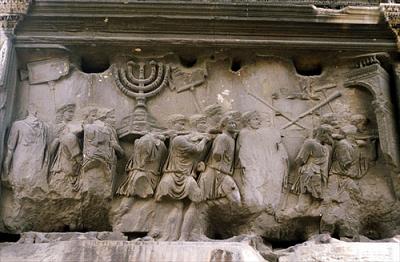|
|
 |
|
The Manifest Glory of Rome: The Roman Triumph |
|
written
by daw84 / 09.04.2005 |
|
|
| |
Description |
| |
| |

|
| http://harpy.uccs.edu/
roman/html/arches.htm |
| Fig. 5 |
| Arch of Titus |
| |
|
| |

|
| http://www.utexas.edu/courses/
romanciv/Romancivimages16/
day16captions.htm |
| Fig. 6 |
| Northern Interior Frieze |
| |
|
| |

|
| http://www.utexas.edu/courses/
romanciv/Romancivimages16/
day16captions.htm |
| Fig. 7 |
| Southern Interior Frieze |
| |
|
| |

|
| http://www.antiquemap
sandprints.com/TURNER.htm |
| Fig. 8 |
| Arch of Titus Incorporated into Frangipane Wall |
| |
|
| |

|
| http://www.vroma.org/
~forum/images.html |
| Fig. 9 |
| Arch of Titus up the Via Sacra |
| |
|
Like other triumphal arches in memory of triumphs such as the Arch of Constantine and the Arch of Julius Caesar, the Arch of Titus stands tall as a tangible memory of the great achievements of Titus, Vespasian, and Domitian. The inscription on the attic reads, “The Senate and People of Rome to the Divine Titus, Son of Divine Vespasian, Vespasianus Augustus,” and because it recognizes Titus as divine, it was built after his death, by Domitian in 81 AD. The surviving parts of the arch, the interior friezes, as well as the part of the attic facing the Colosseum, are made of Pantelic Marble. The rest of the arch was reconstructed by Valadier in the 1820’s using Travertine stone.
The most famous features of this magnificent arch are its intricately-detailed interior freizes. The north frieze shows Titus in the midst of his triumphal glory. He is depicted riding in his triumphal chariot drawn by four incredible, white horses. In the chariot with him rides Victory, on the verge of crowning Titus with a wreath of laurel, and the cart is being guided by Rome. On the opposite frieze, the proud returning Roman soldiers hoist the spoils from the temple of Jerusalem. Hundreds of years later, the silver trumpets and Table of Shewbread remain clearly visible. Most impressively, however, is the enormous seven-branched menorah that lies in the center of this relief, obviously the most glorious item in the entire triumph. The prisoners of war march dejectedly before the soldiers, anticipating their approaching death.
The outside of the arch may have originally contained additional friezes showing the triumph. The arch, however, was incorporated into a wall of the Frangipane family in the middle ages when large, powerful families were battling for control of Rome. Although the outside of the arch was destroyed in the process, and even more was significantly damaged in wars of the 12th and 13th centuries, in many ways the wall around the arch served to conserve this monument just as other structures throughout Rome built over ancient structures served to preserve them.
The arch itself ascends over the Via Sacra at its highest point. Approaching the arch from the East, one walks on the Via Sacra traveling along the exact route of the ancient triumphs. Deep grooves from chariots traveling this busy road remain in the large stones of which it was paved long ago.
Etruscan portals are credited as the predecessors to the triumphal arches. Although great speculation takes place over the role of different parts of Etruscan life, little is known for certain, but the portals probably served as passageways into and out of their great cities.
|
| |
|
| |
|
|
 |
|





